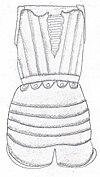Hoguine
| Hoguine | |
|---|---|

|
|
| Information | |
| Weapon type: | Protective weapon |
| Designations: | Hoguine, Hoguine Plates |
| Use: | weapon |
| Working time: | around 16th century |
| Region of origin / author: |
Europe , armory |
| Distribution: | Europe |
| Lists on the subject | |
The hoguine is an armament part of European protective weapons .
description
The hoguine is usually made of steel. It is part of the back armor, which is used exclusively on armor for foot combat. The hoguine begins below the hip and consists of ribbon-shaped steel plates that are arranged horizontally and overlapping. These plates run to below the buttocks. There are separate plate parts for each leg that lie against the thigh. The hoguine is used to protect the buttocks on armor for foot combat. They cannot be used on armor intended for mounted use, as they make it impossible to sit in the saddle . A copy of this type of armor is on display in the Metropolitan Museum , New York .
Individual evidence
- ↑ George Cameron Stone , Donald J. LaRocca: A Glossary of the Construction, Decoration and Use of Arms and Armor: in All Countries and in All Times. Courier Dover Publications, 1999, ISBN 978-0-486-40726-5 (Reprint), page 294 f.
- ↑ Armor with Hoguine on the website of the Metropolitan Museum / New York (English, available online, accessed on July 19, 2011).
literature
- British Archaeological Association, Royal Archaeological Institute of Great Britain and Ireland: The Archaeological journal. Volume 69, Royal Archaeological Institute., 1912, pp. 79, 82.
- Francis M. Kelly, Randolph Schwabe: A short history of costume & armor. Courier Dover Publications, 2002, ISBN 978-0-486-42264-0 , page 46.